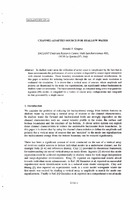| dc.contributor.author | Gingras, Donald F. | |
| dc.date.accessioned | 2018-10-11T14:05:39Z | |
| dc.date.available | 2018-10-11T14:05:39Z | |
| dc.date.issued | 1993/08 | |
| dc.identifier | 798 | |
| dc.identifier.govdoc | CP-42/1 | |
| dc.identifier.uri | http://hdl.handle.net/20.500.12489/132 | |
| dc.description.abstract | In shallow water areas the utilization of active sonar is complicated by the fact that in these environments the performance of active systems is degraded by source signal interaction with channel boundaries. These boundary interactions result in increased reverberation. In this paper a method for reducing backscatter through the use of single mode excitation is evaluated via simulation. It is shown that a vertical array of sources, whose amplitude and polarity are determined by the mode one eigenfunction, can significantly reduce backscatter in shallow water environments. The backscattered energy, as computed using a two-way parabolic equation (PE) model, is computed for a variety of source array configurations and compared to that generated by a single source. | |
| dc.format | 22 p. : ill. : 19 fig. ; digital, PDF file | |
| dc.language | English | |
| dc.publisher | NATO. SACLANTCEN | |
| dc.source | In: Low frequency active sonar (SACLANTCEN Conference Proceedings CP-42), vol. 1, 1993, pp. C/12-1 - C/12-22. | |
| dc.subject | Active sonar | |
| dc.subject | Active arrays | |
| dc.subject | Signal processing | |
| dc.subject | Acoustic scattering | |
| dc.subject | Shallow water | |
| dc.subject | Parabolic equations | |
| dc.subject | Sonar mathematical models | |
| dc.title | Channel-adapted source for shallow water | |
| dc.type | Papers and Articles | |
| dc.type | Conference Proceedings (CP) | |
